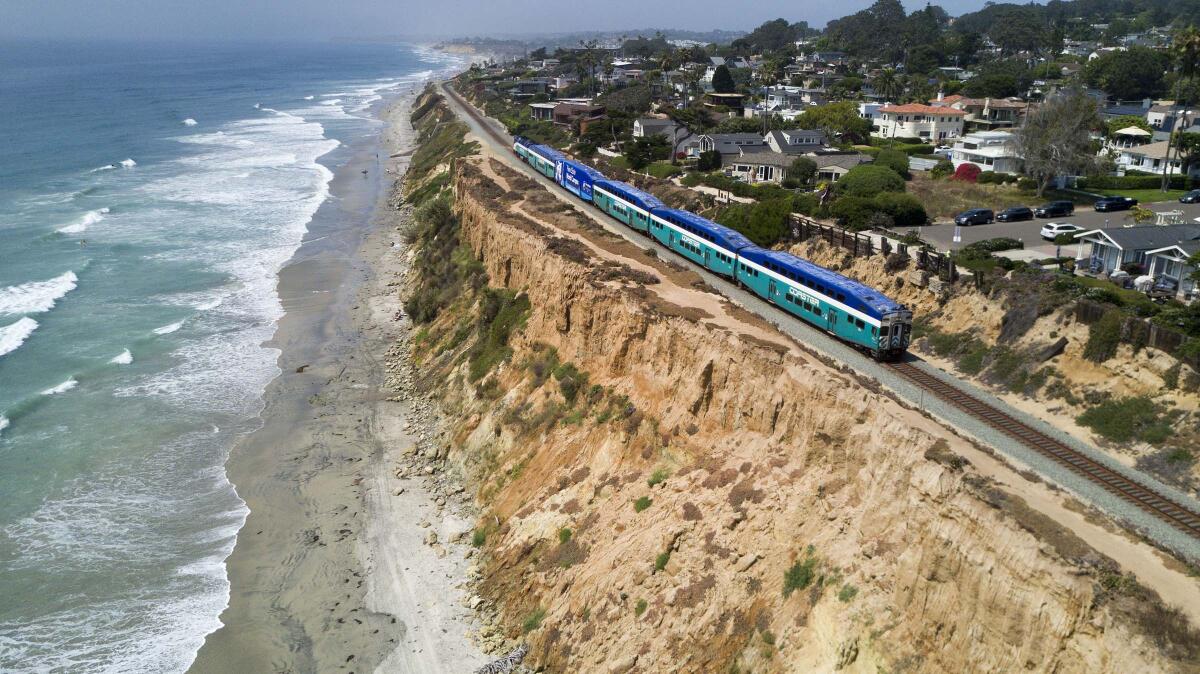Bluff collapse warning system proposed for northern San Diego County coastline

Assemblywoman Boerner Horvath’s bill allocates $2.5 million for accelerated research.
- Share via
SAN DIEGO — A bill passed by the Assembly Natural Resources Committee last week would allocate $2.5 million for research that could help create an early warning system for California’s coastal bluff collapses.
AB 66 by Assemblywoman Tasha Boerner Horvath (D-Encinitas) would give Scripps Institution of Oceanography the job of researching when and why bluffs fail, so potentially catastrophic failures of the seaside cliffs can be predicted.
Three women were killed at Grandview Beach in Encinitas in August 2019 when a 30- by 25-foot block of sandstone broke loose and fell on a family as they were sunbathing. A similar collapse killed a San Francisco woman earlier that year at Ft. Funston.
More recently, a bluff collapse one month ago came within 35 feet of the coastal railroad that carries dozens of passenger and freight trains daily in Del Mar. Transit officials have begun $10.5 million in emergency repairs needed to safeguard the tracks and allow trains to resume their normal speeds on what is the only rail corridor between San Diego, Los Angeles and San Luis Obispo on the Central Coast.
“What happened to the three women in 2019 in Leucadia and, tragically, to other valued members of our community up and down the state is unacceptable, and we must use science and data-driven innovation to keep our communities safer,” Boerner Horvath said in a media release. “Fortunately, we have a great partner in our backyard with Scripps, and while AB 66 focuses on the area from Torrey Pines to Oceanside, the information we will gather will be invaluable for our state.”
Boerner Horvath represents the state’s 76th Assembly District, which includes Camp Pendleton, Oceanside, Vista, Carlsbad and Encinitas.
Rising sea levels bring increasing coastal erosion, and bluff failures are a constant threat to California beachgoers and coastal neighborhoods.
“This bill can significantly advance research on the dynamics of cliff collapse along California’s coastlines,” said Mark Zumberge, a research geophysicist at Scripps. “With funding from this bill, we would aim to gain a better understanding of the processes leading up to cliff failures.
“Our goal is to learn how deformations are impacted by the tides, large surf, groundwater and rainfall to see if we can answer the question of whether signals exist that can forecast where and when an increased risk for collapse is developing,” he said.
Coastal erosion threatens development worth billions of dollars, from homes and highways to Camp Pendleton Marine Corps Base and the retired San Onofre Nuclear Generation Station with its tons of stored spent fuel.
“We know a lot about long-term trends, including cliff retreat and what can make them collapse,” said Del Mar City Councilman Dwight Worden. “What we don’t know is what’s likely to come down now — we can’t tell you if it’s safe to lay your towel on the beach in this location, and this is a huge issue for local cities.”
The rate of coastal erosion, estimated at 6 inches annually in recent years, is expected to more than double by 2100, according to scientists at the U.S. Geological Survey.
AB 66 will next be heard by the Assembly Appropriations Committee.
Diehl writes for the San Diego Union-Tribune.
More to Read
Sign up for Essential California
The most important California stories and recommendations in your inbox every morning.
You may occasionally receive promotional content from the Los Angeles Times.











